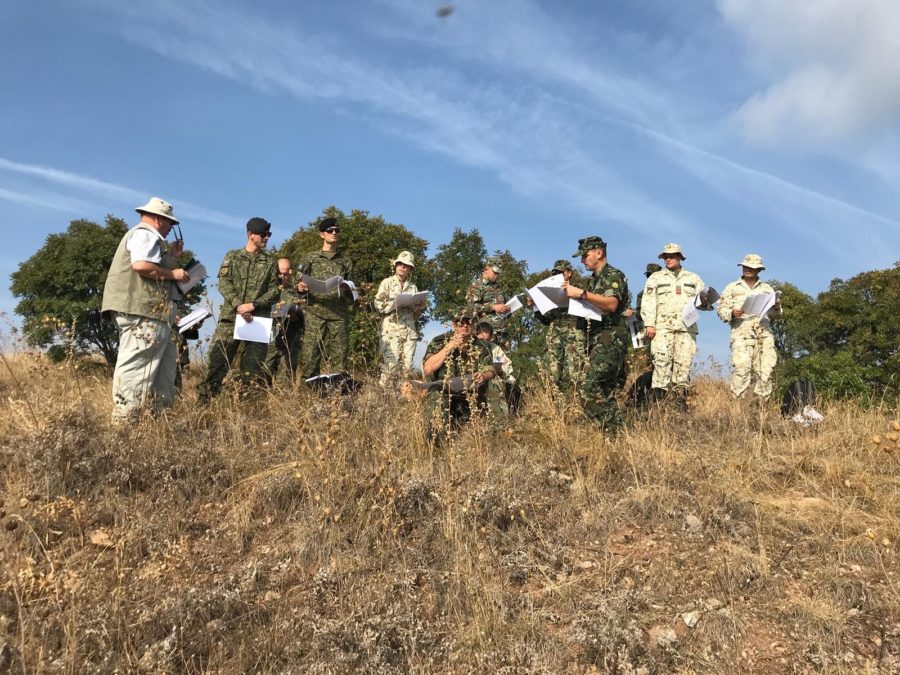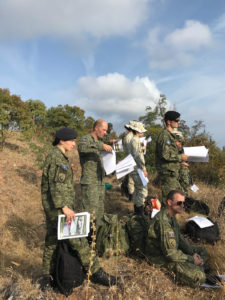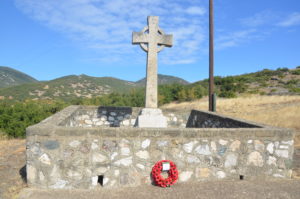6th November 2018 Skopje, North Macedonia
Bringing people together through history

“He lay out upon a precipitous hillside, under the light of a waning moon. It was very quiet; the guns, active throughout the night, were now dumb. On either side of him, in a silence only broken by their heavy breathing, the men of the battalion lay prone along a series of tape lines, laid to mark the jumping off place for the attack.” This passage from the book “On The Anvil” provides a description of a soldier preparing to attack the dragon backed shaped ridge line, known as Pip Ridge, in the hills above Dojran on the 18 September 1918. The author, L.I. Crawford, was a Captain with the 9th South Lancashire Regiment which lost 254 of its ranks, killed, wounded or missing, when it attacked the Pip Ridge.
One hundred years later on the 18th September 2018, army officers from Bulgaria, Kosovo and Macedonia, followed in the footsteps of the soldiers who attacked and defended the trenches along the ridge 100 years earlier. These present-day allies were in Dojran to participate in a battlefield study to learn from the events of September 1918.
Battlefield studies are used extensively by the British and other NATO armies as a method to learn from the past. A battlefield study is a deliberate, organised look at a former battlefield in order to learn. These activities are not about glorifying war, but to learn lessons from the past.

In the spring of 2017 I was approached by the British Defence Attaché in Skopje, Lieutenant Colonel Richard Parry, to create and conduct a battlefield study for the annual International Summer Campus hosted by the Macedonian Ministry of Defence and the Macedonian Military Academy. With the assistance of the British Army’s expert on battlefield studies, Lieutenant Colonel Mathew Whitchurch, and support of the British Embassy Skopje, we developed Exercise Dojran Crown for officer cadets representing thirteen nations and their support staff. The feedback was very positive, and we were asked to repeat the exercise in 2018, again with the support of the British Embassy in Skopje. Over 275 cadets, a mix of young men and women, and their support staff participated in the exercise during the 2017 & 2018 Summer Campus.
With the 100th anniversary of the second battle of Dojran approaching, Lieutenant Colonel Parry’s successor, Lieutenant Colonel Andrew Layton, requested a study be developed which focused on the events of 18th of September 1918. Exercise Balkan Grenadier II was successfully delivered 17 – 19 September 2018. As this exercise took place on the 100th anniversary of the second battle of Dojran it provided a unique way to commemorate the service and sacrifice of soldiers from all nations who served on the Salonika Front.
The exercise began on the evening of the 17th with participants receiving study materials, maps and question list. An introduction to the British Army model for conducting a battlefield study and the Salonika Front campaign were presented. During this phase the participants where split into multi-national teams (syndicates). During the exercise the syndicate members work together to answer questions which requires them to compare and contrast military doctrine then and now.
The next morning, we loaded onto Macedonian Army vehicles for a very bumpy ride to Pip Ridge. Moving to the location of the former defensive positions I provided the historical background of the events that took place and then the syndicates began discussion and presentation of responses to specific questions. The importance of being able to visit the ground where battles took place is critical for effective understanding how ground impacts operations and learning from the past. The terrain on Pip Ridge is steep and by walking up the hills it is easy to appreciate how difficult it would have been for the attacking British forces in 1918.
After two hours of discussion and debate we moved by foot towards Kale Tepe. Along the way we stopped at several reinforced concrete bunkers that were used as artillery gun positions by the Bulgarians during the war. This provided the group an idea of the strength of the defence which faced the British forces at the time.
On the northern slope of Kale Tepe is the Ferdinand Chesma (water tap), a great place to top up a bottle with fresh spring water. The Chesma was constructed by the Bulgarian Army during the first world war to honour their comrades of the 34th Troyan Regiment. It was reconstructed in 2010. Here a short lunch break was made before beginning the ascent of Kale Tepe.
On the top of Kale Tepe is a partially destroyed bunker which had been an observation post that dominated the entire Dojran battlefield known to the British as “The Devil’s Eye.” From this vantage point the syndicates examined and discussed the attack of the British 7th battalion of the South Wales Borderers’ Regiment and the effective use of machine guns by the defenders. It was during this action that the unit’s commanding officer, Lieutenant Colonel Daniel Burges was awarded Britain’s highest award for gallantry – the Victoria Cross.
On completion of the day’s field activities we made our way by foot back to Dojran. In the evening an informal dinner was held. In attendance was Her Majesty’s Ambassador to Macedonia Rachel Galloway, Bulgarian Embassy to Macedonia Charge d’affaires Daniela Boudinova, the Mayor of Dojran Mr. Ango Angov, Brigadier General Gjorgoski of the Army of the Republic of Macedonia, and the Defence Attachés from Britain and Bulgaria. It was an honour to have such a distinguished group present for the dinner. The British Ambassador took the opportunity to recognise those present and to commemorate all those that served here during the First World War.
An early start the next morning saw the group once again load onto the Macedonian Army transport. This time the destination was the hills near Kosturino. It was here in November of 1915 that the 10th Irish Division relieved the French 156th Division. Between the 29th of October and the 12th of December 1915, the 10th Irish Division would suffer 1,209 casualties (killed, wounded or missing) in this area. After ground orientation and a historical briefing, syndicate activities carried on. On the return trip to Dojran, a brief stop was made at the 10th Irish Memorial Cross in Rabrovo.

After lunch the final activity was to find out what was each person’s take-a-way from the exercise. Responses ranged from learning a new teaching method, to gaining a better understanding of the tactics and doctrine used then and now. All participants thought the activity was very useful and supported the conduct of further battlefield studies. They also considered how they can use battlefield studies in their units.
It has been an honour to create and deliver battlefield studies for such diverse groups of people. These activities are more than soldiers learning important lessons from war. Participants get to know each other, cultures and way of working. Witnessing the exchange of social media profiles, emails, hugs and handshakes at the end of these exercises, it’s easy to see that strangers have quickly become friends. These relationships are invaluable for bringing people together on a professional and personal level. Other benefits are providing people an opportunity to visit another country or to see a part of their own country and history of which they know very little about. Hotels, restaurants and shops in the local community are benefiting from increased business.
I would to thank the present and previous British Ambassadors and Defence Attachés for their support of this initiative that has to date brought so many people together professionally and personally.
Glenn Stennes is a retired member of the Canadian Army who now lives in Macedonia. He is the President of the Macedonian Front Society, an NGO in the Republic of Macedonia with a primary focus on Protection, Preservation and Promotion of the artefacts and events of 1915 – 1918. Glenn is a member of the International Guild of Battlefield Guides and the Salonika Campaign Society.

Good job Spanky, well thought out and presented!
Cheers, hope all is well
Bill Seymour